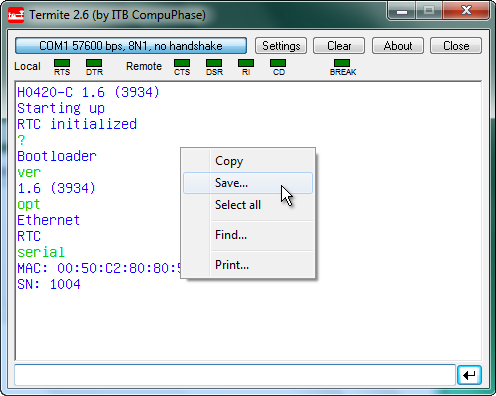This support article will demonstrate the differences and similarities between the pairing process for Bluetooth SPP (Serial Port Profile) and Bluetooth Low Energy (BLE). Although these two Bluetooth profiles are commonly used for a variety of applications, the focus of this guide is on the implications related to using Serialio's Bluetooth scanners in either SPP or BLE mode.Click here to learn more about the difference between Bluetooth LE and Bluetooth SPP.
The most important difference when switching between BLE and SPP is that you CANNOT pair through your device's Bluetooth Settings while using BLE mode. Below are basic instructions on how to pair your Bluetooth scanner is each mode.
How to Pair in SPP Mode
1. Take the appropriate actions to put your device in Bluetooth SPP mode.
Step-by-step guide to add virtual COM port Windows 10: Following these steps with Virtual Serial Port Driver (VSPD) will enable you to easily create virtual serial ports on a Windows 10 machine: Download and install VSPD on your Windows 10 computer. Launch the application and navigate to the “Manage Ports” tab.
2. Make your device discoverable and connectable.

- For a Bluetooth-enabled device or accessory to work with your PC that’s running Windows 10, the device needs to use one of the supported Bluetooth profiles below. To find out what profiles your Bluetooth device supports, check the documentation that came with it or visit the manufacturer’s website.
- I installed the Toshiba Bluetooth Card in my Inspiron 6400. It's working and can see my Treo Phone. When I went to set up HotSync to work via Bluetooth, the wizard on the Treo said 'To use a Bluetooth HotSync, you must create a virtual serial port on your PC.' So, looking for a way to create.
- Free Serial Analyzer is a non-intrusive Serial Port sniffer and software RS-232/RS-422/RS-485 protocol analyzer for Windows. It supports monitoring of serial port data on both 32-bit / 64-bit Windows desktop/server platforms including Windows 10 and Windows 2019 Server. Our software-based free serial port monitor is an ideal alternative to.
3. Navigate to your host device's Bluetooth settings
4. Tap on your scanner's Bluetooth name to pair with it.
5. After pairing through your host device's Bluetooth settings, launch (or open) the application you wish to use with your scanner.
6. Navigate to the application's settings/connection manager.
Windows 10 Bluetooth Com Port Issues
7. Pair your scanner with the Bluetooth-SPP supporting application.
How to Pair in BLE Mode
1. Take the appropriate actions to put your device in Bluetooth Low Energy (BLE) mode.

2. Make your device discoverable.

Bluetooth Virtual Serial Port Windows 10
3. Launch the BLE-enabled application you wish to connect to.
4. Navigate to the connection/device manager for the BLE-enabled application.
Windows 10 Bluetooth Serial Port Settings
5. Pair your scanner directly to the application (bypassing the host device's Bluetooth settings)
I was thinking about a comment on a Gist I wrote some time ago and thought I’d written a blog post on the topic, but when I couldn’t find any sign of it I decided to start from scratch as I’d have probably needed to update it anyway.
The Bluetooth stack in Windows has supported virtual COM ports since the beginning (Windows XP SP2 if you can remember that far back!). It’s important to understand the difference between these and any Serial Port Bluetooth device. The Virtual COM port functionality exists purely for interop with older software – you can make a Bluetooth device appear to the system as a wired Serial device and open a COM port and talk to the device as if it was plugged into your PC.
If you’re writing modern software which talks to devices then you would use a Bluetooth API – either 32feet.NET or the platform specific Bluetooth API directly. If not you can create a virtual COM port. Throughout Windows 10’s lifetime the Bluetooth options have been slowly moving to the modern Settings experience but the old Control Panel still exists and is used for some additional functionality – Virtual Serial ports are still in there.
The port can be either incoming – you have a listening service which other devices can connect to; or outgoing where you connect to a specific remote device. From Settings > Devices select “More Bluetooth options” from the righthand menu.
From the resulting “classic” control panel applet select the “COM ports” tab to see configured ports or to set one up.
When I reworked the 32feet.NET library I decided not to include the COM port functionality as it’s only relevant to Windows and is for legacy code only. However I put together the required code to enumerate all the Bluetooth virtual COM ports on the system in a Gist which you can find here:-
I’ve just updated it as I noticed an issue with the null termination of the port names so it is now correctly trimmed. The class is very simple to use – the following will write out all the configured ports to the debug console:-
Windows 10 Bluetooth Serial Portal
This will match the contents of the Control Panel shown above.